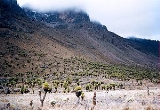
Mount Kenya National Park
Encyclopedia
Mount Kenya National Park, established in 1949, protects the region surrounding Mount Kenya
. Initially it was a forest reserve before being announced as a national park. Currently the national park is within the forest reserve which encircles it. In April 1978 the area was designated a UNESCO
Biosphere Reserve
. The national park and the forest reserve, combined, became a UNESCO World Heritage Site
in 1997.
The Government of Kenya
had four reasons for creating a national park on and around Mount Kenya. These were the importance of tourism
for the local and national economies, to preserve an area of great scenic beauty, to conserve the biodiversity
within the park, and to preserve the water catchment for the surrounding area.
The national park has an area of 715 square kilometres (276 sq mi), most of which is above the 3000 metres (9,842.5 ft) contour line. The forest reserve has an area of 705 square kilometres (272 sq mi). Combined this makes the area of the UNESCO World Heritage Site 1420 square kilometres (548 sq mi).
A small portion of this park's borders near heavy populations have electrified fences
to keep the elephants out of the surrounding farmland
. Volcanic sediment
in the surrounding region's soil
and the huge volume of fresh water coming down the slopes makes the area particularly favourable for agriculture
.
At lower altitudes Colobus and other monkey
s and Cape Buffalo are prevalent.
Mount Kenya
Mount Kenya is the highest mountain in Kenya and the second-highest in Africa, after Kilimanjaro. The highest peaks of the mountain are Batian , Nelion and Point Lenana . Mount Kenya is located in central Kenya, just south of the equator, around north-northeast of the capital Nairobi...
. Initially it was a forest reserve before being announced as a national park. Currently the national park is within the forest reserve which encircles it. In April 1978 the area was designated a UNESCO
UNESCO
The United Nations Educational, Scientific and Cultural Organization is a specialized agency of the United Nations...
Biosphere Reserve
Biosphere reserve
The Man and the Biosphere Programme of UNESCO was established in 1971 to promote interdisciplinary approaches to management, research and education in ecosystem conservation and sustainable use of natural resources.-Development:...
. The national park and the forest reserve, combined, became a UNESCO World Heritage Site
World Heritage Site
A UNESCO World Heritage Site is a place that is listed by the UNESCO as of special cultural or physical significance...
in 1997.
The Government of Kenya
Politics of Kenya
The Politics of Kenya take place in a framework of a presidential representative democratic republic, whereby the President of Kenya is both head of state and head of government, and of a multi-party system. Recent constitutional amendments have enabled sharing of executive powers between the...
had four reasons for creating a national park on and around Mount Kenya. These were the importance of tourism
Tourism
Tourism is travel for recreational, leisure or business purposes. The World Tourism Organization defines tourists as people "traveling to and staying in places outside their usual environment for not more than one consecutive year for leisure, business and other purposes".Tourism has become a...
for the local and national economies, to preserve an area of great scenic beauty, to conserve the biodiversity
Biodiversity
Biodiversity is the degree of variation of life forms within a given ecosystem, biome, or an entire planet. Biodiversity is a measure of the health of ecosystems. Biodiversity is in part a function of climate. In terrestrial habitats, tropical regions are typically rich whereas polar regions...
within the park, and to preserve the water catchment for the surrounding area.
The national park has an area of 715 square kilometres (276 sq mi), most of which is above the 3000 metres (9,842.5 ft) contour line. The forest reserve has an area of 705 square kilometres (272 sq mi). Combined this makes the area of the UNESCO World Heritage Site 1420 square kilometres (548 sq mi).
A small portion of this park's borders near heavy populations have electrified fences
Electric fence
An electric fence is a barrier that uses electric shocks to deter animals or people from crossing a boundary. The voltage of the shock may have effects ranging from uncomfortable, to painful or even lethal...
to keep the elephants out of the surrounding farmland
Arable land
In geography and agriculture, arable land is land that can be used for growing crops. It includes all land under temporary crops , temporary meadows for mowing or pasture, land under market and kitchen gardens and land temporarily fallow...
. Volcanic sediment
Sediment
Sediment is naturally occurring material that is broken down by processes of weathering and erosion, and is subsequently transported by the action of fluids such as wind, water, or ice, and/or by the force of gravity acting on the particle itself....
in the surrounding region's soil
Soil
Soil is a natural body consisting of layers of mineral constituents of variable thicknesses, which differ from the parent materials in their morphological, physical, chemical, and mineralogical characteristics...
and the huge volume of fresh water coming down the slopes makes the area particularly favourable for agriculture
Agriculture
Agriculture is the cultivation of animals, plants, fungi and other life forms for food, fiber, and other products used to sustain life. Agriculture was the key implement in the rise of sedentary human civilization, whereby farming of domesticated species created food surpluses that nurtured the...
.
At lower altitudes Colobus and other monkey
Monkey
A monkey is a primate, either an Old World monkey or a New World monkey. There are about 260 known living species of monkey. Many are arboreal, although there are species that live primarily on the ground, such as baboons. Monkeys are generally considered to be intelligent. Unlike apes, monkeys...
s and Cape Buffalo are prevalent.

